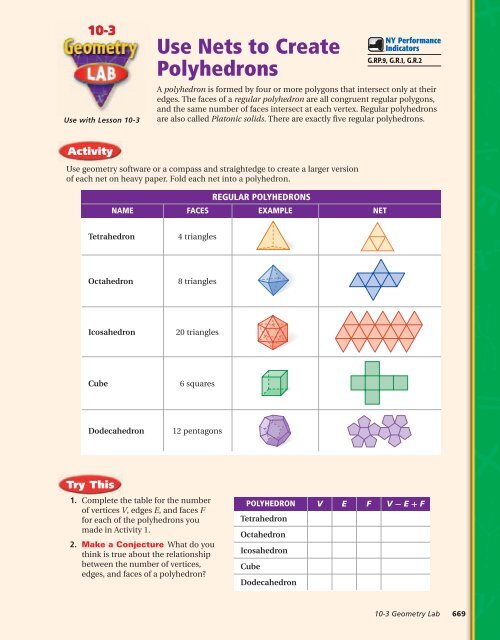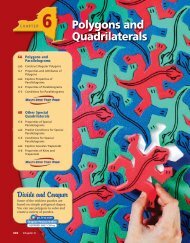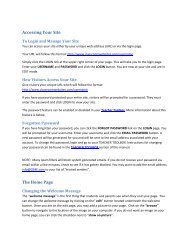Spatial Reasoning
Chapter 10 Spatial Reasonin - 30-Minute Websites for Teachers ...
Chapter 10 Spatial Reasonin - 30-Minute Websites for Teachers ...
- No tags were found...
Create successful ePaper yourself
Turn your PDF publications into a flip-book with our unique Google optimized e-Paper software.
10-3<br />
Use with Lesson 10-3<br />
Use Nets to Create<br />
Polyhedrons<br />
NY Performance<br />
Indicators<br />
G.RP.9, G.R.1, G.R.2<br />
A polyhedron is formed by four or more polygons that intersect only at their<br />
edges. The faces of a regular polyhedron are all congruent regular polygons,<br />
and the same number of faces intersect at each vertex. Regular polyhedrons<br />
are also called Platonic solids. There are exactly five regular polyhedrons.<br />
Activity<br />
Use geometry software or a compass and straightedge to create a larger version<br />
of each net on heavy paper. Fold each net into a polyhedron.<br />
REGULAR POLYHEDRONS<br />
NAME FACES EXAMPLE NET<br />
Tetrahedron<br />
4 triangles<br />
Octahedron<br />
8 triangles<br />
Icosahedron<br />
20 triangles<br />
Cube<br />
6 squares<br />
Dodecahedron<br />
12 pentagons<br />
Try This<br />
1. Complete the table for the number<br />
of vertices V, edges E, and faces F<br />
POLYHEDRON V E F V - E + F<br />
for each of the polyhedrons you<br />
made in Activity 1.<br />
2. Make a Conjecture What do you<br />
think is true about the relationship<br />
between the number of vertices,<br />
edges, and faces of a polyhedron?<br />
Tetrahedron<br />
Octahedron<br />
Icosahedron<br />
Cube<br />
Dodecahedron<br />
10-3 Geometry Lab 669






